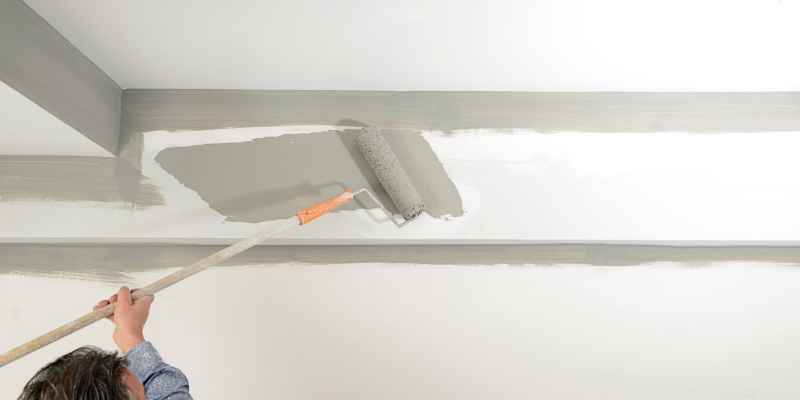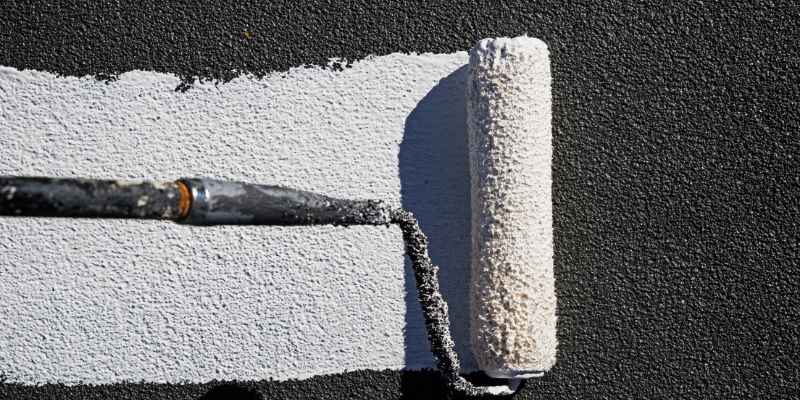Applying a second coat of paint usually makes the color appear darker and more saturated. This is because the second coat adds more pigment to the surface, reducing the amount of light that passes through the paint film.
Adding more layers of the same paint won’t affect the color or richness of the final product. In fact, applying a second coat of paint increases overall durability and color coverage, reduces the possibility of bleeding through paint underneath, and provides greater protection for the painted surface, making it look better and last longer.
Understanding the effects of adding more paint is important for achieving the desired outcome when painting the interior or exterior of a space.
Paint Drying Process
When it comes to painting, does applying a second coat make the color darker? The answer is usually yes. The second coat adds more pigment to the surface, reducing the amount of light that passes through the paint film, making the color appear darker and more saturated.
However, it won’t change the color from what’s on the paint swatch if the paint is mixed properly.
Painting is a task that involves various stages, including choosing the right type of paint, selecting the color, and drying the paint. In addition, people often wonder whether applying a second coat of paint will make it darker or lighter. To understand if paint gets darker with a second coat, one must understand the paint drying process.
Why Paint Changes Color When It Dries:
Paints typically dry darker due to the evaporative process during the drying of paint. As paint dries, the solvents evaporate, leaving behind solid pigments that reflect light in a different way than when the paint is wet. The pigments in the paint become more concentrated and absorb more light as they dry, which makes the color look darker.
Factors That Affect Paint Color:
Several factors can affect the color of the paint, such as the type of paint, the number of coats, and the drying conditions. Adding more layers of the same paint won’t affect the color, but it can increase the richness of the final product. The drying conditions, such as temperature and humidity, can also affect the paint color.
Factors That Can Ensure Consistency in Paint Color:
To ensure that the color of paint remains consistent, it is important to follow the manufacturer’s instructions when applying the paint. Additionally, using high-quality paint can help maintain color consistency. Moreover, it is always a good idea to apply a second coat of paint to ensure that the color appears consistent and rich.
In conclusion, applying a second coat of paint will usually make the color appear darker and more saturated due to the added pigment. However, the change is minimal and mostly dependent on the color and type of paint used, the number of coats, and the drying conditions. By following the manufacturer’s instructions and using high-quality paint, one can ensure that the paint color remains consistent throughout the drying process.
Impact Of Applying A Second Coat
Applying a second coat of paint will usually make the color appear darker and more saturated. This is because the second coat adds more pigment to the surface, reducing the amount of light that passes through the paint film. However, it won’t actually darken the color, just make it richer.
enhance the overall appearance of the painted surface. Adding a second coat of paint can have a significant impact on the final product. Not only does it increase the durability of the painted surface, but it also provides better coverage and protection. In this section, we will discuss the effects of applying a second coat of paint, including its impact on paint color and appearance, and the reasons for doing so.
Effects On Paint Color And Appearance
When you apply a second coat of paint, it can change the color and appearance of the final product. Usually, the color will appear darker and more saturated, as the second coat adds more pigment to the surface. This can reduce the amount of light that passes through the paint film and results in a darker hue. Additionally, applying a second coat can help to even out any patchy areas or areas where the underlying color is still visible, providing better coverage overall.
Reasons For Applying A Second Coat
There are several reasons why you might choose to apply a second coat of paint. One of the most common reasons is to achieve better coverage and a more even finish. By adding a second coat, you can fill in any thin areas and make the color more consistent and appealing. Additionally, a second coat can increase the durability of the painted surface and protect it from damage, especially if you are using a high-quality paint.
In summary, applying a second coat of paint can have a significant impact on the final product’s color and appearance. It can help to even out the paint coverage, increase durability and protection, and provide a more consistent and aesthetically pleasing finish. Overall, it is a wise investment of time and resources to apply a second coat of paint, especially if you want the best results possible.
Color Perception And Lighting

Paints typically dry darker, including oil, acrylic, and latex paints, but this doesn’t necessarily mean the color will be different than what’s on the paint swatch. Adding layers of the same paint won’t impact the color or richness of the final product.
It is unlikely that you will achieve complete coverage with just one coat, regardless of the paint brand.
The color of paint is not always perceived in the same way due to many factors, one of which is lighting. The way light falls on a painted surface can dramatically affect how it looks to the human eye, making the color darker or lighter than intended. To properly understand the relationship between lighting and color perception, it is crucial to know how lighting affects paint color.
The role of lighting in color perception
Lighting plays a vital role in how the human eye perceives color because color is just a reflection of light. The color of paint may look different in different lighting conditions because of the way it absorbs and reflects light. For instance, different colors look lighter or darker under direct sunlight or when viewed in the evening under artificial light. Since color perception can vary due to lighting, it’s essential to consider the lighting conditions where the room with the painted surface will be.
How lighting affects paint color
The general rule of thumb is that applying a second coat of paint will usually make the color appear darker and richer. This occurs because the second coat adds more pigment to the surface, reducing the amount of light that passes through the paint film. Factors such as lighting, temperature, and humidity also impact how paint dries, which can affect the ultimate color perception.
Tips for proper color perception when painting
The following tips can help to ensure proper color perception when painting:
– Always paint in natural light. This will give a better representation of how the color will look in the room compared to painting in artificial light.
– Use a consistent light source while painting. If you use different types of lighting during the painting process, it can affect how the color looks in the end.
– Observe the paint samples in the room color you are planning to paint. Hold the samples up against the walls to see how they look in your room’s natural lighting conditions. This will give you an idea of how the color will appear when painted on your walls and add consistency to the end result.
– Always apply a second coat of paint. This will ensure the color looks even and consistent throughout the paint job while helping to darken and enrich the color.
In conclusion, lighting dramatically affects paint color perception. It’s crucial to consider lighting conditions before choosing a paint color and to pay attention to the lighting during the painting process. Applying a second coat of paint can help darken and enrich the color, but it’s essential to be consistent in lighting while painting. Following these tips can help ensure an accurate portrayal of the color you desire.
Common Misconceptions
Applying a second coat of paint doesn’t necessarily make the color darker, but it can make it richer and more saturated. This is due to the second coat adding more pigment to the surface, reducing the amount of light that passes through the paint film.
It is important to note that proper mixing of the paint is necessary to achieve the desired color.
When it comes to painting, there are many misconceptions that people have. One of the most common misconceptions is that applying a second coat of paint will always make the paint lighter. This is not entirely true. There are a number of factors that can impact the color of paint, including the type of paint you use and the underlying color of the surface you are painting.
Myth of paint lightening with additional coats:
The myth that paint lightens with additional coats has been around for a long time. However, this is not always the case. While some types of paint, such as oil-based paints, may dry slightly lighter than they appear when wet, this is not always the case. In fact, applying a second coat of paint is usually necessary in order to achieve the desired color and coverage. In most cases, a second coat of paint will make the color appear darker and more saturated.
Effect of color undertones on paint color:
Another factor that can impact the color of paint is the underlying color or undertones of the surface you are painting. For example, if you are painting over a white wall with blue undertones, this can impact the color of the paint you choose. It is important to consider the underlying color and undertones of the surface you are painting when choosing a paint color.
Conclusion:
In conclusion, while the myth that paint lightens with additional coats is not entirely true, there are a number of factors that can impact the color of paint. Applying a second coat of paint is usually necessary in order to achieve the desired color and coverage. When choosing a paint color, it is important to consider the underlying color and undertones of the surface you are painting.
Factors Affecting Darkening Or Lightening Of Paint

Applying a second coat of paint can make the color richer and more saturated, but it won’t actually darken or lighten the paint. The second coat adds more pigment to the surface, which reduces the amount of light that passes through the paint film.
However, adding multiple layers of the same paint won’t affect the final color or richness.
he color, but it can make it appear darker. This is because of various factors affecting the darkening or lightening of paint. In this section, we’ll look at some of these factors and how they impact the final color of your painted surface.
Type Of Paint Used
The type of paint used can significantly affect how much the color will darken or lighten. For instance, oil-based paints tend to darken over time, while water-based paints may lighten. Some high-quality paint brands may also have additives that help to maintain the color consistency even after multiple coats.
Surface Preparation
The surface preparation is one of the most critical factors that can affect the final color of your painted surface. If you don’t prepare the surface correctly, the paint may not adhere properly, which can cause unevenness or discoloration. The color may appear darker if there are dark spots or stains on the surface, and lighter if there are patches of the surface that are not entirely covered by the paint.
Application Method
The technique used to apply the paint can also impact the final color. If you apply too much paint in one area, it may appear darker than the rest of the surface. On the other hand, if you don’t use enough paint, the surface may appear lighter. Brush strokes and the direction in which you apply the paint can also affect how much the color will darken or lighten. A roller may apply paint more evenly and smoothly than a brush, and may result in less color variation.
In conclusion, the factors affecting the darkening or lightening of paint are extensive. From the type of paint used to the application method, each factor plays a crucial role in the final color of your painted surface. Therefore, it’s always advisable to follow the recommended procedures to ensure that you achieve the desired color consistency.
Tips For Consistent Paint Color
Applying a second coat of paint can make the color appear darker and more saturated. This is because the second coat adds more pigment to the surface, reducing the amount of light that passes through the paint film. However, if the paint is mixed properly, it should look the same as the color swatch once it dries.
hen it comes to painting, consistency is key in achieving a professional and polished look. One of the most common questions is whether paint gets darker with the second coat. Applying a second coat of paint does not necessarily result in a darker hue, but it can make the color look richer and more vibrant. The key to consistent paint color lies in proper mixing of paint, using high-quality paint, and optimal application techniques. In this section, we will explore some tips for achieving consistent paint color for your next painting project.
Proper Mixing Of Paint
Mixing paint thoroughly is vital in achieving consistent paint color. When opening a new can of paint, be sure to stir it well to ensure the color pigments are evenly distributed throughout the paint. Sometimes, the pigment can settle at the bottom of the can, resulting in uneven color application. Use a stir stick or drill attachment to mix the paint well before applying it to the surface.
Using High-quality Paint
Using high-quality paint not only ensures better coverage with fewer coats, but also helps maintain consistent color. Cheap paint can have uneven pigment distribution and may not adhere well to the surface, resulting in a patchy and inconsistent finish. Using a good-quality paint can also result in fewer drips and splatters, which can affect color consistency and ruin the overall look of your painting project.
Optimal Application Techniques
Using the right application techniques can also help achieve consistent paint color. It’s essential to apply paint in thin, even coats to avoid drips and unevenness. Allow the first coat of paint to dry before applying the second coat to avoid smudging or lifting the first coat. If you apply the second coat while the first coat is still wet, the color may become streaky and uneven. Also, remember to use consistent lighting when painting to ensure color accuracy throughout the project.
In conclusion, achieving consistent paint color requires proper mixing of paint, using high-quality paint, and optimal application techniques. By following these tips, you can achieve a professional and polished look for your painting project.
Frequently Asked Questions On Does Paint Get Darker With Second Coat
Does Paint Get Darker Or Lighter When It Dries?
Paints typically dry darker, especially oil, acrylic, and latex paints. But if you mix the paint properly, it should look the same as the color you picked out once it dries. Adding multiple layers of the same paint won’t affect the color or richness of the final product.
So, it won’t lighten or darken; it’ll just appear richer and more saturated.
Do More Layers Of Paint Make It Darker?
No, adding more layers of paint does not make the color darker. Adding more paint will make the color richer but won’t affect its darkness. Using a second coat of paint will ensure better coverage, more durability, and stronger protection for the surface.
Will Paint Look Better After Second Coat?
Applying a second coat of paint does not necessarily darken the color, but it can make it appear richer and more saturated. This is because the second coat adds more pigment, reducing the amount of light that passes through the paint film.
Additionally, applying two coats of paint increases durability, color coverage, and provides greater protection for the painted surface. Always apply a second topcoat to achieve the desired look.
What Is The Benefit Of A Second Coat Of Paint?
A second coat of paint increases color coverage and durability, reduces the possibility of bleed through, and provides greater protection for the painted surface. It won’t darken the color but can make it richer. The second coat adds more pigment to the surface, reducing the amount of light passing through it.
In short, with a second coat of paint, it will look better and last longer.
Conclusion
Applying a second coat of paint will not necessarily make the color darker, but it will make it richer and more saturated. It’s important to ensure proper coverage with each coat to achieve the desired color and avoid touch-up problems.
Multiple coats of paint also increase durability and provide greater protection for the painted surface. So, go ahead and apply that second coat for a longer-lasting, more vibrant finish.


